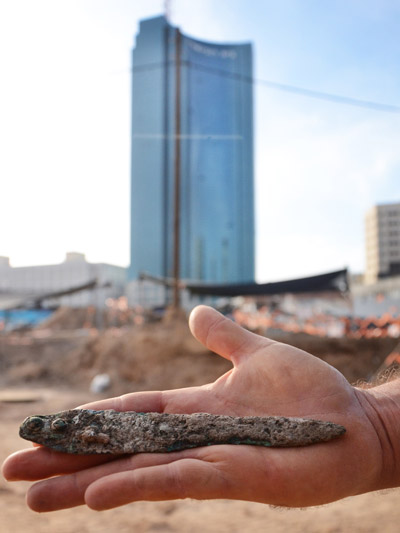Evidence indicating the presence of an ancient Egyptian population from more than 5,000 years ago is being exposed these days on HaMasger Street next to the Ma'ariv Bridge in downtown Tel Aviv, in salvage excavations the Israel Antiquities Authority is conducting prior to the construction of office buildings by the Rubenstein Company.
According to Diego Barkan, director of the archaeological excavation on behalf of the Israel Antiquities Authority, "We found seventeen pits in the excavations, which were used to store agricultural produce in the Early Bronze Age I (3500-3000-BCE). Among the hundreds of pottery sherds that characterize the local culture, a number of fragments of large ceramic basins were discovered that were made in an Egyptian tradition and were used to prepare beer. These vessels were manufactured with straw temper or some other organic material in order to strengthen them, a method not customary in the local pottery industry.
Vessels such as these were found in the Egyptian administrative building that was excavated at 'En Besor. On the basis of previously conducted excavations in the region we knew there is an Early Bronze Age site here, but this excavation is the first evidence we have of an Egyptian occupation in the center of Tel Aviv at that time. This is also the northernmost evidence we have of an Egyptian presence in the Early Bronze Age I.
Until now we were only aware of an Egyptian presence in the northern Negev and southern coastal plain, whereby the northernmost point of Egyptian occupation occurred in Azor. Now we know that they also appreciated what the Tel Aviv region had to offer and that they too knew how to enjoy a glass of beer, just as Tel Avivians do today."
It is interesting to note that beer was the "national drink of Egypt" in ancient times, and that it was a basic commodity like bread. Beer was consumed by the entire population, regardless of age, gender or status. It was made from a mixture of barley and water that was partially baked and then left to ferment in the sun. Various fruit concentrates were added to this mixture in order to flavor the beer. The mixture was filtered in special vessels and was ready for use. Excavations conducted in Egypt's delta region uncovered breweries that indicate beer was already being produced in the mid-fourth millennium BC.
Barkan adds that a bronze dagger and flint tools dating 6,000 years ago to the Chalcolithic period were also found at the site.
According to Moshe Ajami, the Tel Aviv district archaeologist at the Israel Antiquities Authority, "The archaeological excavations and documentation of the area will finish today. The site will be approved for development and the research will continue in the laboratories of the Israel Antiquities Authority."
 Bronze dagger against the backdrop of the excavation and the towersCopyright: Yoli Shwartz, courtesy Israel Antiquities Authority
Bronze dagger against the backdrop of the excavation and the towersCopyright: Yoli Shwartz, courtesy Israel Antiquities Authority